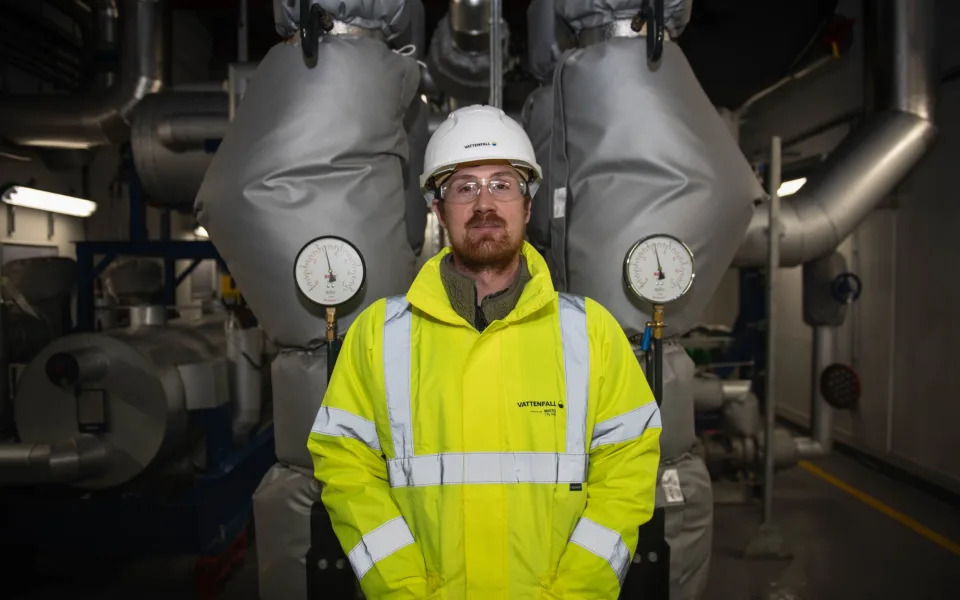Matt Oliver
Sat, 30 December 2023

Vattenfall's operations project manager Jason Lee says the heat pump is like an giant, industrial-sized radiator - Lee Thomas
Perched on the side of a floating harbour inside a large, wood-clad shed, a gigantic heat pump – the biggest one in Britain – is drawing water from the river and using it to provide heating to surrounding buildings.
It was built by Bristol City Council but taken over recently by Swedish state energy giant Vattenfall, which is now expanding the system across the city.
“The heat pump is working hard today,” says Jason Lee, the operations project manager, as we step into the large room where the device is housed.
At the plant, a maximum of 153 litres per second is being abstracted from the river. On the day we visit, the water temperature is about eight degrees Celsius.
The heat pump then uses the water to warm a refrigerant chemical with a very low boiling point (in this case ammonia), which turns into gas and is then tightly compressed.
This in turn raises the temperature, with the gas then used to heat pipes that carry separate water in a circuit around the local district.
After the heat pump has worked its magic, the water originally abstracted is returned to the river about three to four degrees colder than before.
So long as the water temperature is around 7 degrees or more, the machine can achieve a “coefficient” of about three, says Lee. This means every kilowatt of electricity put into the heat pump generates about three kilowatts of heat energy in return.
This system, with the help of a huge water tank, then pumps water around the network’s pipes, delivering it to nearby buildings at a minimum of 65 degrees.
“It is like a giant, industrial-sized radiator,” says Lee.
Customers already include a school, a health clinic, student accommodation, a BT office and a neighbouring block of apartments.
At the moment, the Bristol network is powered by the heat pump, a biomass boiler and natural gas. But under the city’s plans to go greener, there are hopes that the gas could be replaced by more heat pumps, renewables or heat energy from nearby data centres and waste incineration sites.
Vattenfall has also set its sights on other cities, including Edinburgh, Glasgow and London. It is also in talks with Dundee and Stirling, with a target to be in five to eight cities by 2030.
The Swedish firm has long operated such heat networks in Western Europe but is now one of several companies vying to dominate the nascent UK market, which is tiny by comparison.
Just 2pc of heat here comes from heat networks, compared to 50pc in Vattenfall’s native Sweden.
But with the UK Government hoping to gradually switch households away from natural gas heating under plans to reach “net zero” carbon emissions, that is likely to change.
A strategy published by ministers envisages that around 18pc of building heat will eventually come from district networks like the one in Bristol.
These have the potential to be an “efficient, cost-effective and flexible” solution for greener heating, according to the International Energy Agency, providing the energy they run on is clean.
Importantly, heat networks may also be the answer for people who cannot get a heat pump, the main alternative to gas boilers being pushed by the Government.
A typical air source heat pump will still set a homeowner back by about £14,000 (before a government grant of £7,500) and some homes may not be suitable for them, says Jenny Curtis, managing director of Vattenfall Heat UK.
“The narrative when we talk about the decarbonisation of heat tends to boil down to gas boilers versus heat pumps, but we’re really missing a huge chunk of the story,” she says.
“We need the right technology, in the right places, at the right price. It’s going to be a mixed picture and district heating is a huge part of the solution.”
Vattenfall can trace its heat network roots back to the 1890s, when one of its subsidiaries first started operating in Hamburg, Germany.
Today its networks serve more than two million homes and businesses across Europe, in cities such as Amsterdam and Berlin.
In the UK, the Government’s heat and buildings strategy suggests heat networks will make the most difference in built-up areas such as cities.
But others believe the technology has wider potential and are pushing for it to even be considered as a direct replacement for gas heating in suburbs and rural villages.
One of these is Truro-based Kensa Group, which builds district heating networks powered by ground source heat pumps. Earlier this year, the company – which makes heat pumps in the UK – received £70m in investment from Legal & General Capital and Octopus Energy.
It is using the money to finance the construction of heat networks itself, with L&G then owning the assets.
So far, the company has built heat networks for several social housing schemes, including one recently in Thurrock. But it has also been trialling a heat network in the Cornish village of Stithians, which it hopes could become a model for others across the country.
This draws heat from the earth via 42 boreholes, each about 100 metres deep. Villagers were offered free installation of the new heating system in their homes in exchange for paying Kensa a monthly standing charge.

The picturesque village of Stithians in Cornwall is trialling a ground source heat pump network - Jo Shreeve
Tamsin Lishman, Kensa’s chief executive, says the approach means households still have a “heating box in a cupboard”, similar to their gas boiler.
“We see massive potential for this to replace the gas grid,” she explains. “They work everywhere, but we see them as particularly suitable for medium-density housing, by which I mean classic terraced streets.”
Kensa’s investor, L&G, also believes the technology is scalable and is looking to partner with the company to become a major owner of heat networks in the UK.
“They’ve delivered it to social housing, retrofitted blocks of flats, new build development sites and a village, so it’s very exciting that it can have such a beneficial impact for society,” says John Bromley, managing director of clean energy investments at L&G Capital.
“But also, on our end it’s actually a sensible investment that makes good returns.”
Yet there are still questions about how heat networks will work in practice, including how consumers will be protected from the risk of unfair prices.
The Heat Trust, a non-profit consumer champion, warns heat networks are de-facto monopolies, with customers unable to change suppliers.
Most are also owned by landlords who outsource their operations to specialist companies, which can lead to a lack of transparency about how fees are calculated.
Perhaps most crucially, heat networks are not covered by the energy price cap, which proved disastrous for some consumers during the 2021 energy crisis.
According to the Heat Trust, some residents reliant on heat networks faced 700pc bill increases as landlords simply passed on the cost increases they were facing when buying energy on the wholesale market.
The Government is currently holding a consultation on how to regulate heat networks and protect consumers in the future, with Ofgem handed responsibility under the Energy Act.
A government spokesman says the act gives Ofgem “the power to intervene on unfair prices for heat network customers”, while the Secretary of State now has powers to cap prices should they become “significantly higher compared to other heating systems”.
Despite this, regulating the many thousands of heat networks scattered across the country poses an “unprecedented challenge”, the Heat Trust warns.
“It will be crucial to demonstrate that Ofgem has an appetite for enforcement activity,” the trust says.
Improving the efficiency of networks, which can lose 30pc-40pc of their heat typically, will also be crucial to prevent consumers from paying the price for poor standards.
Meanwhile, separate changes to the planning system will soon require councils to sort different areas into “heating zones”, denoting which types of heating should be prioritised.
Vattenfall is hoping this will make things easier as it pushes to expand, with its flagship project in Bristol poised to grow from just two zones to seven in the next three years.
That presents opportunities but also big challenges, admits Vattenfall’s Curtis.
“All the pieces of the puzzle are coming together,” she adds. “The challenge we’re going to have is how to quickly ramp up the supply chain.
“But it’s coming, it’s big and it’s exciting.”
No comments:
Post a Comment